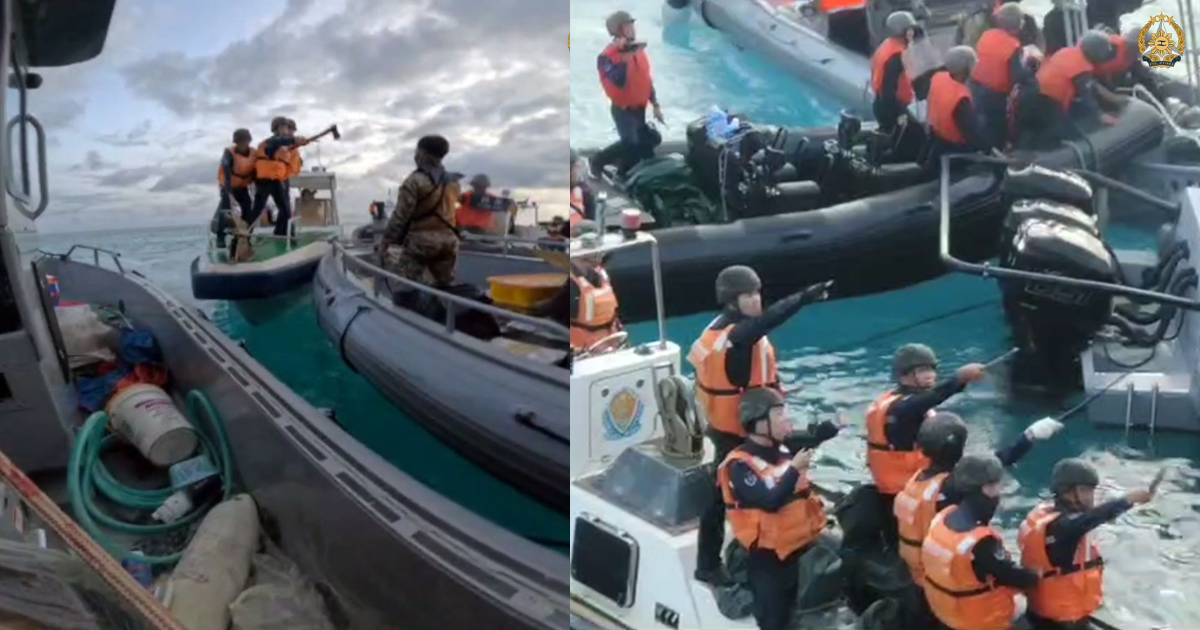Actions speak louder than words

Stills from video footages show armed Chinese Coast Guard personnel threaten Armed Forces of the Philippines soldiers during a humanitarian rotation and resupply mission at BRP Sierra Madre in Ayungin Shoal on June 17. Photos courtesy of Armed Forces of the Philippines
By Manuel Mogato | Date 07-03-2024
MANILA — Every time a serious incident happens in the West Philippine Sea, expect Biden administration officials to immediately call their Filipino counterparts.
They would condemn China’s illegal and dangerous actions against lawful operations to deliver humanitarian supplies to troops stationed aboard BRP Sierra Madre.
Following the same old and tired script, they would reaffirm Washington’s “ironclad” support to Manila under the 1951 Mutual Defense Treaty (MDT).
After the June 17 incident in Ayungin Shoal, US State Secretary Antony Blinken, Defense Secretary Lloyd Austin, and National Security Adviser Jake Sullivan made separate phone calls to their counterparts – Enrique Manalo, Gilberto Teodoro, and Eduardo Año, respectively, in succeeding days.
The Philippines welcomes the statement of support but needs stronger actions to demonstrate the robust alliance between the two allies.
President Ferdinand Marcos Jr. said he wanted a more robust response to the Chinese actions.
Marcos said the diplomatic protests are not enough to deter China’s violations of Philippine sovereign rights in its maritime zones. (Also read: A bigger role for the United States in the West Philippine Sea)
Since Marcos assumed office in July 2022, Manila has filed several notes verbale, protesting China’s presence and activities in the West Philippine Sea.
Beijing simply ignored them, insisting it had undisputable rights over the waters claimed in the South China Sea.
However, no state has recognized and supported China’s claim based on its historical nine-dash-line policy.
The Philippines’ jurisdiction and sovereign rights in its 200 nautical mile exclusive economic zone were recognized under the 1982 United Nations Convention on the Law of the Sea.
It was further strengthened by a 2016 landmark ruling from the Permanent Court of Arbitration, recognizing Manila’s economic rights on features over which China seized control.
The Philippines needs more help to improve its defense capabilities and enhance its skills and capacities to deter China.
Words do not make China cringe and stop its harassment. It only encourages Beijing to escalate the situation further. (Also read: The Inevitability of Armed Conflict in the South China Sea)
From shadowing and blocking Philippine vessels sailing into Bajo de Masinloc and Ayungin Shoal, China has started to ram and blast them with water cannons.
On June 17, the Chinese Coast Guard, armed with axes, machetes, and knives, went further. They boarded the Philippine Navy’s rigid-hulled inflatable boats (RHIB) boats, took some weapons, and punctured the vessels.
General Romeo Brawner Jr described the Chinese actions as an act of piracy and demanded the return of the confiscated guns.
The military would not start a shooting war in the West Philippine Sea. It would only defend itself once it was fired upon.
China knew the rules of engagement. It will not use force and invite the United States to intervene under the Mutual Defense Treaty.
China will only employ its gray zone tactics, testing the patience of the US and its allies, including the Philippines.
With conflicts in Ukraine and the Middle East, the United States is not prepared to fight another war on another front.
China is also not prepared to confront the United States, knowing its military remained inferior to the Americans despite its military modernization and buildup programs.
The US has also been busy preparing to defend Taiwan. It is in the midst of developing logistics bases in the Philippines and moving missiles and other defensive equipment to deter threats from China, North Korea, and Russia in the Indo-Pscific region.
This situation would continue until 2027 when the US expected China to invade Taiwan to force a reunification.
The Philippines must also prepare for a major conflict in the region. (Also read: Emergent Strategies and Tactics in the Asia-Pacific)
Whether the Philippines would like it or not, it would be dragged into a conflict because of its proximity.
China’s warships and warplanes would pass through the country’s sea lanes and airspace when it finally launched an invasion into Taiwan.
While making its own preparations, the Philippines would need its allies to upgrade its capabilities and capacities through equipment transfers, training, and exercises.
It has to expand its alliances and defense cooperation with like-minded countries.
While it can still benefit from the alliance, it should maximize the support and assistance it is getting.
Apart from improvements in several local bases identified as EDCA locations, the US has not transferred arms to the Philippines.
It has only pledged $1 billion in foreign military sales credits next year. Japan has also promised equipment transfers and Australia has offered to build coastal boats for the Coast Guard.
Other states, like Indonesia, Israel, South Korea, Tukey, United Kingdom, France, and Sweden have been offering to sell weapons systems.
The Philippines needs other states to help increase deterrence. Actions are needed not just words. (Also read: US forms triangle with treaty allies Japan and Philippines to fend off invoking MDT’s Article V)
However, in the end, the Philippines has to fight and defend its territorial integrity sovereignty, and sovereign rights in the West Philippine Sea without relying on the US and other allies.
The Philippines has to stand on its own and fight for its rights, dignity, and honor.
Tags: Security
